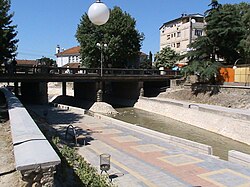Kavadarci
|
Kavadarci Кавадарци |
|||
|---|---|---|---|

Luda Mara River flowing through Kavadarci
|
|||
|
|||
| Location within Macedonia | |||
| Coordinates: 41°26′N 22°00′E / 41.433°N 22.000°ECoordinates: 41°26′N 22°00′E / 41.433°N 22.000°E | |||
| Country |
|
||
| Municipality | Kavadarci Municipality | ||
| Government | |||
| • Mayor | Aleksandar Panov (VMRO-DPMNE) | ||
| Elevation | 150 m (490 ft) | ||
| Population (2002) | |||
| • Total | 38,741 | ||
| Time zone | CET (UTC+1) | ||
| • Summer (DST) | CEST (UTC+2) | ||
| Postal code | 1430 | ||
| Area code(s) | +389 043 | ||
| Car plates | KA | ||
| Climate | Cfa | ||
| Website | www.kavadarci.gov.mk/ | ||
Kavadarci (Macedonian: Кавадарци [kaˈvadartsi]) is a town in the Tikveš region of the Republic of Macedonia. In the heart of Macedonia’s wine country, it is home to the largest winery in southeastern Europe, named after the Tikveš plain. The town of Kavadarci is the seat of Kavadarci Municipality. Situated near Kavadarci is Macedonia's largest artificial lake, Lake Tikveš.
In the Tikveš region around Kavadarci, many artefacts and structures have been discovered dating back to prehistoric times. Bronze and ceramic artefacts were discovered at an archaeological site in the nearby town of Stobi (Macedonian: Стоби) dating to the 6th and 7th century BC. This town is said to have been established during the Hellenic period; being on the main road of Via Egnatia that led from the Danube to the Aegean Sea meant it became an important military, economic and cultural hub. The establishment of a mint during the Roman period aided in its prosperity and achieving the status of municipium, denars and coins reading “Municipium Stobensium” were also produced in this area. Numerous buildings and monuments of this era such as a theatre have been discovered. A Jewish community is said to have existed in Stobi during the 3rd century, however, its synagogue was torn down in the 4th century and a Christian basilica was built in its place. In the late 5th and early 6th century, the town was devastated in the great Avaro-Slavonic invasions. Stobi which was previously the centre of this region was replaced by the new village of Dukena.
...
Wikipedia



